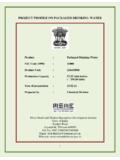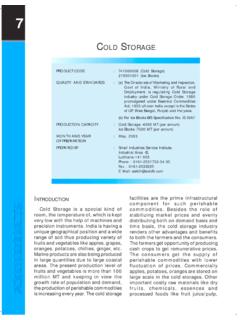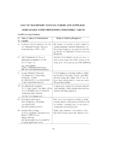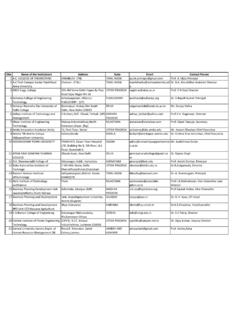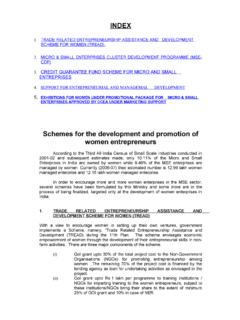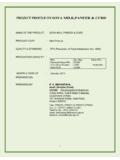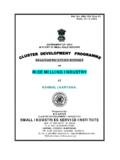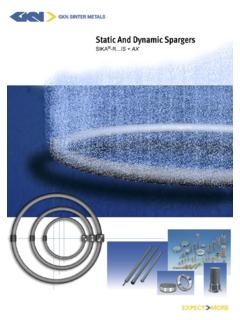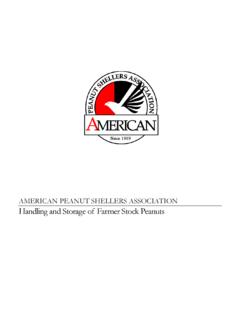Transcription of PROJECT REPORT ON PRECAST CONCRETE …
1 1 PROJECT REPORT ON PRECAST CONCRETE PRODUCTS 1. Product : PRECAST CONCRETE PRODUCTS 2. Quality Standards :IS:9893-2007/.IS: 15658-2006/,IS: 5751-1984 3. Production Capacity quantity : lakhs bricks Value : Rs. lakhs 4. Month & Year : March 2011 5. Prepared by : Asst. Director (G/C) MSME-DI, Guindy, Chennai. 2 1. Introduction: A CONCRETE block is primarily used as a building material in the construction of walls. It is sometimes called a CONCRETE masonry unit (CMU). A CONCRETE block is one of several PRECAST CONCRETE products used in construction .
2 The term PRECAST refers to the fact that the blocks are formed and hardened before they are brought to the job site. Most CONCRETE blocks have one or more hollow cavities, and their sides may be cast smooth or with a design. In use, CONCRETE blocks are stacked one at a time and held together with fresh CONCRETE mortar to form the desired length and height of the wall. CONCRETE mortar was used by the Romans as early as 200 to bind shaped stones together in the construction of buildings. During the reign of the Roman emperor Caligula, in 37-41 , small blocks of PRECAST CONCRETE were used as a construction material in the region around present-day Naples, Italy.
3 Much of the CONCRETE technology developed by the Romans was lost after the fall of the Roman Empire in the fifth century. It was not until 1824 that the English stonemason Joseph Aspdin developed portland cement, which became one of the key components of modern CONCRETE . The first hollow CONCRETE block was designed in 1890 by Harmon S. Palmer in the United States. After 10 years of experimenting, Palmer patented the design in 1900. Palmer's blocks were 8 in ( cm) by 10 in ( cm) by 30 in ( cm), and they were so heavy they had to be lifted into place with a small crane. By 1905, an estimated 1,500 companies were manufacturing CONCRETE blocks in the United States.
4 These early blocks were usually cast by hand, and the average output was about 10 blocks per person per hour. Today, CONCRETE block manufacturing is a highly automated process that can produce up to 2,000 blocks per hour. 2. Raw Materials The CONCRETE commonly used to make CONCRETE blocks is a mixture of powdered portland cement, water, sand, and gravel. This produces a light gray block with a fine surface texture and a high compressive strength. A typical CONCRETE block weighs 38-43 lb ( kg). In general, the CONCRETE mixture used for blocks has a higher percentage of sand and a lower percentage of gravel and water than the CONCRETE mixtures used for general construction purposes.
5 This produces a very dry, stiff mixture that holds its shape when it is removed from the block mold. 3 If granulated coal or volcanic cinders are used instead of sand and gravel, the resulting block is commonly called a cinder block. This produces a dark gray block with a medium-to-coarse surface texture, good strength, good sound-deadening properties, and a higher thermal insulating value than a CONCRETE block. A typical cinder block weighs 26-33 lb ( kg). Lightweight CONCRETE blocks are made by replacing the sand and gravel with expanded clay, shale, or slate. Expanded clay, shale, and slate are produced by crushing the raw materials and heating them to about 2000 F (1093 C).
6 At this temperature the material bloats, or puffs up, because of the rapid generation of gases caused by the combustion of small quantities of organic material trapped inside. A typical light-weight block weighs 22-28 lb ( kg) and is used to build non-load-bearing walls and partitions. Expanded blast furnace slag, as well as natural volcanic materials such as pumice and scoria, are also used to make lightweight blocks. In addition to the basic components, the CONCRETE mixture used to make blocks may also contain various chemicals, called admixtures, to alter curing time, increase compressive strength, or improve workability. The mixture may have pigments added to give the blocks a uniform color throughout, or the surface of the blocks may be coated with a baked-on glaze to give a decorative effect or to provide protection against chemical attack.
7 The glazes are usually made with a thermosetting resinous binder, silica sand, and color pigments. Design The shapes and sizes of most common CONCRETE blocks have been standardized to ensure uniform building construction . The most common block size in the United States is referred to as an 8-by-8-by-16 block, with the nominal measurements of 8 in ( cm) high by 8 in ( cm) deep by 16 in ( cm) wide. This nominal measurement includes room for a bead of mortar, and the block itself actually measures in ( cm) high by in ( cm) deep by in ( cm) wide. Many progressive block manufacturers offer variations on the basic block to achieve unique visual effects or to provide desirable structural features for specialized applications.
8 For example, one manufacturer offers a block specifically designed to resist water leakage through exterior walls. The block incorporates a water repellent admixture to reduce the CONCRETE 's absorption and permeability, a beveled upper edge to shed water away from the horizontal mortar joint, and a series of internal grooves and channels to direct the flow of any crack-induced leakage away from the interior surface. 4 Another block design, called a split-faced block, includes a rough, stone-like texture on one face of the block instead of a smooth face. This gives the block the architectural appearance of a cut and dressed stone.
9 When manufacturers design a new block, they must consider not only the desired shape, but also the manufacturing process required to make that shape. Shapes that require complex molds or additional steps in the molding process may slow production and result in increased costs. In some cases, these increased costs may offset the benefits of the new design and make the block too expensive. Manufacturing Process The production of CONCRETE blocks consists of four basic processes: mixing, molding, curing, and cubing. Some manufacturing plants produce only CONCRETE blocks, while others may produce a wide variety of PRECAST CONCRETE products including blocks, flat paver stones, and decorative landscaping pieces such as lawn edging.
10 Some plants are capable of producing 2,000 or more blocks per hour. The following steps are commonly used to manufacture CONCRETE blocks. Mixing The sand and gravel are stored outside in piles and are transferred into storage bins in the plant by a conveyor belt as they are needed. The portland cement is stored outside in large vertical silos to protect it from moisture. As a production run starts, the required amounts of sand, gravel, and cement are transferred by gravity or by mechanical means to a weigh batcher which measures the proper amounts of each material. The dry materials then flow into a stationary mixer where they are blended together for several minutes.
